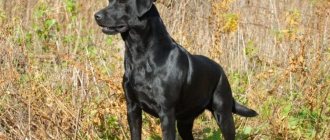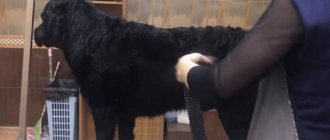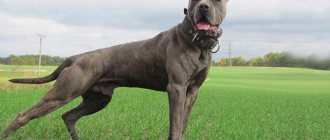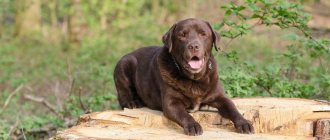Labrador is a breed that is friendly to humans and other dogs. But some representatives of this breed exhibit aggression for a reason.
The cute and friendly Labrador Retriever makes many dog lovers want to immediately take such a pet into their home. Aggression in a Labrador is surprising and bewildering, since it is believed that dogs of this breed lack the gene responsible for the manifestation of aggression towards both humans and relatives. Despite this, some Labradors can attack people and other dogs, trying to bark and bite. What is the reason for this behavior and can it be corrected?
Labrador bites. Aggression in a Labrador Why does a Labrador attack a person?
Dog, two years old, Labrador. He started throwing himself at people in the entrance and at home! What to do? We are already going to give it away.
Answer
When a Labrador puppy appears in the house, the baby instantly becomes the object of everyone's attention and love. Everyone strives to caress the dog and take him in his arms. Time passes, the dog gets older, the pet continues to be pampered. A grown dog becomes like a capricious, spoiled child.
If suddenly circumstances develop in an undesirable way for the dog, the four-legged friend is capable of showing aggression. As a rule, the first reaction of the owners is to give a treat, calm them down, and “make amends” to the pet.
A vicious circle develops, myths begin to emerge about the incredible cruelty and stupidity of Labradors.
Why does aggression occur?
Aggressive behavior in Labradors is the result of a number of reasons.
- A common form is dominance aggression. Usually found in young males who have not walked.
- Aggression is caused by fear; more often the root of evil lies in improper upbringing and violations of socialization. Labradors are afraid of their owner or of a certain type of person. Labradors are breeds that are characterized by defense in the form of manifestations of aggression.
- Territorial aggression is associated with defending one's own territory. A dog considers the area of an apartment or house, entrance, yard, car to be its own.
- Predator aggression. With this type of aggression, dogs often attack birds, chickens, cats, and small animals. This is an instinctive behavior characteristic of wild nature. Often such animals gather in flocks.
- Fighting aggression. The species is more typical for fighting breeds; it is trained artificially.
- Aggression as a rage syndrome in an animal. The phenomenon is considered a mental disorder. A dog is capable of suddenly attacking a person or animals, causing harm, and then continues to behave as if nothing had happened. As a rule, pathology is resolved exclusively by euthanasia.
Correction of dominance aggression
Elimination of this type of aggression is carried out by re-education, medications and castration of the animal. If the doctor has established an accurate diagnosis, he prescribes special medications for the pet to correct behavior. However, this is not a very effective measure and is used for a short time. Re-education will be much more effective in this situation.
The pet must be explained its place in the hierarchical ladder of the family. Do not allow the dog to sleep in a place other than the one specifically designated for the pet. Feed the dog when the family has finished eating.
When passing through a door or gate, make sure that the dog leaves only after you, and does not pull on the leash. The furry friend must “earn” lunch and a walk.
To do this, before feeding, give a simple command and wait for it to be completed.
Remember that open confrontation is dangerous if the animal is agitated and aggressive. Avoid direct eye contact.
The dog's commands are clear, short and understandable. It is unlikely that the dog will understand the phrase: “For God’s sake, don’t do that again.”
Correction of fear aggression
First of all, it is recommended to take care to identify the cause of fear and eliminate it. In addition to external factors, heredity can play a significant role. The pet becomes aggressive solely out of fear. The first parent of the animal, for example, was considered aggressive, the second - overly fearful. The puppy could inherit the character traits of both parents.
If the dog begins to rush out of fear, try to distract the attention. Try using your favorite toy. It is acceptable to offer the dog his favorite treat and invite him to play.
In the long term, it is recommended to carry out desensitization - gradually get used to the factor that causes fear. You should start with small “doses”, gradually increasing the time of contact with the frightening moment. If the dog shows signs of fear, do not show that you have noticed, pronounce commands in a calm, firm voice, and perhaps try to distract the animal with a game or treat.
Standard training techniques
Try to find a way to the dog's heart through the stomach. Many dogs are constantly hungry. Labradors are no exception. Dogs are excellent at motivating themselves with treats.
If the dog tries to rush at you, offer a toy; when he takes it, praise and treat. When the pet gets used to it, it is permissible to replace the treat with praise and stroking the head and withers.
The treat is given to the animal in small pieces. Instead of ready-made dog treats, you can use frozen liver or boiled kidneys. This is a budget alternative and easy to prepare at home. Some Labradors are happy to do what is required, even for pieces of their usual food.
Food as a motivator is used only at the beginning of re-education. Gradually, treats are given less frequently and are more often replaced with verbal praise.
You can resort to a strategy to distract your Labrador when the dog tries to lunge at people. Seeing the dog's intention to rush at a passerby, try to distract him with a game or give a command. First, do your workout at home, where there are few distractions. Gradually make the task more difficult by going outside with your pet and continuing the exercise.
Quote from the message Cute Labrador attacked a 3-year-old child
Three-year-old Logan from the UK was bitten by a Labrador. The owner with the dog and a rather adult puppy were walking not far from the playground. Logan's mom was touched: "They were beautiful, and I thought it was cute that the dogs were walking close to the children."
The woman bent down and first let the bitch smell her hand and stroked it. Then she walked away and wanted to approach the puppy, but at that time the dog rushed at her son, who was standing nearby. “We didn’t understand what happened. My son screamed, he was covered in blood, there was blood all over his T-shirt. The owner grabbed the dog and started apologizing.”
Labradors are considered one of the most good-natured dogs that are good with children. However, their behavior can also be unpredictable. Little Logan, who wouldn't go near the dogs at all, ended up needing about 40 stitches. He survived and his eye was saved. But the scars will last a lifetime.
Please be careful around any dog without a muzzle, even if you think they are cute.
Series of messages "":
A dog can bite only from upbringing, or rather the lack thereof, regardless of the breed. There are no aggressive breeds, there are ill-mannered owners. Part 1 -
Sometimes situations happen that shock both you and your Labrador. It is very rare that Labradors show aggression, and when this happens, everyone becomes scared.
Causes of aggression in Labrador retrievers
When you buy a Labrador puppy, everyone tries to caress it and hold it in your arms: how can such a miracle be left alone? Over time, when the dog grows up, you can’t stop spoiling him, so your pet grows up capricious and spoiled, and if the situation is not in his favor, you immediately try to fix everything by petting him, or giving him a treat.
If your dog is the most important person in your family, he may become aggressive. It is worth remembering that a Labrador is a dog like others: it also has teeth and its own status in life. What status your pet has is up to you. If you give her free rein, you or your family members may be bitten.
There is aggression in Labradors, which is directed at other dogs, but there is an explanation for this situation: perhaps your dog was proving its superiority over other dogs, and if two bitches fought, it is possible that both are in heat.
Dogs of any breed do not like bitches who are in heat, so during this period they are aggressive towards others.
How to deal with aggression in Labradors?
Any dog owner needs to remember that if your pet is in heat, you should not walk with other dogs during this period, as it will cause aggression in other females, and males may simply go into a rage. Try to walk away from dogs - this way you will maintain a normal relationship between you and your pet.
When a Labrador pounces on a person, you should immediately punish the dog - and you should punish it instantly, and not after you come home: then your dog is unlikely to understand why he was punished.
If a Labrador attacked, and you did not react in any way, then in the future attacks may be repeated more and more often, so it is worth stopping such actions immediately. If you can’t cope with your dog, contact a canine specialist.
The Labrador is a dog like any other. She is also subject to mood swings and aggression, but only you can stop aggression in your pet. You should not leave this situation for later, and never give your dog a leading role in your family - otherwise you will lose all authority for it.
It’s boiling! Today we were walking in the park, we were walking, not bothering anyone, and then a dog rushed towards us - that horse!, of course, without a muzzle...
I don’t know much about breeds, but it seemed to me that this was a Labrador, he was running so cheerful, wagging his tail and straight at my child. I covered Alina with myself, took her in my arms, and he (or she) jumped and tried to play...
Fuck, I understand that the dog is good-natured, but what if it knocked down a child? What if the child screamed loudly? did you cry? or provoked it in some other way...
Read completely…
Maksyushin’s skills of the last days...
Our trips have a huge impact on Max, he has another leap in development. - Thanks to Yar (Ol, thank you so much for being here), Max began to show his hair and ears - this was not the case before. - He learned to empathize. Now, when someone cries - especially a child - he comes up and pats him on the head - very cute...
-He interacts well with animals - dogs (thanks to his sister and Labrador Fedya), pets them and feeds them))) - Sometimes he feeds ghouls, but more often he puts bread in his mouth)) Apparently he loves bread... - He began to make more sounds...
Source: https://www.kolpinovet.ru/tahikardiya/labrador-kusaetsya-agressiya-u-labradora-pochemu-labrador-napadaet.html
Who to choose - a boy or a girl?
When choosing the gender of your future pet, you should start from the purpose of acquiring it and some psychological and behavioral differences between males and females, due to the performance of different functions in the pack.
The task of male dogs is to explore new places and protect the territory. They are inquisitive and persistent, have leadership qualities, but have no problem obeying someone who is stronger.
The main function of bitches is reproduction. They are more cunning than males and achieve their goals not by acting blindly, but by going through all the options.
Girls are more obedient and calm; it is a little more difficult to achieve obedience from male dogs, but if leadership qualities are demonstrated in a timely manner, problems will not arise.
The maintenance of a dog also affects its physiology. Thus, male dogs, due to the need to mark territory, require longer walks, they are characterized by increased sexuality, which is why they can run after a female in heat.
In girls, behavior changes only during the period of estrus , i.e. no more than 2 times a year, the rest of the time she is sexually neutral .
If there are plans to breed a breed, then the choice should be made in favor of a female.
Aggression in Labradors: how to prevent? Aggression in a Labrador Why does aggression occur?
It’s boiling! Today we were walking in the park, we were walking, not bothering anyone, and then a dog rushed towards us - that horse!, of course, without a muzzle...
I don’t know much about breeds, but it seemed to me that this was a Labrador, he was running so cheerful, wagging his tail and straight at my child. I covered Alina with myself, took her in my arms, and he (or she) jumped and tried to play...
Fuck, I understand that the dog is good-natured, but what if it knocked down a child? What if the child screamed loudly? did you cry? or provoked it in some other way...
Read completely…
Maksyushin’s skills of the last days...
Our trips have a huge impact on Max, he has another leap in development. - Thanks to Yar (Ol, thank you so much for being here), Max began to show his hair and ears - this was not the case before. - He learned to empathize. Now, when someone cries - especially a child - he comes up and pats him on the head - very cute...
-He interacts well with animals - dogs (thanks to his sister and Labrador Fedya), pets them and feeds them))) - Sometimes he feeds ghouls, but more often he puts bread in his mouth)) Apparently he loves bread... - He began to make more sounds...
Instructions
Up to 4 months, the jaws of puppies are still quite weak and their teeth are used not for protection, but for games. At this age, he learns to communicate with his relatives and learn relationships within the pack.
If, while playing with his fellow tribesmen, he plays too hard, he hears an unpleasant squeal and realizes that he has caused pain. This is how he learns to measure the force of his bite. People, including the baby, are perceived by him as relatives, his pack.
And, having already had his own life experience and the habit of biting during games, he transfers this to relationships with his owners.
When the puppy wants to play with the owner, he begins to lightly bite him. If a person pushes him away, then he perceives it as games. The bites intensify.
If you don’t push the baby away and start playing with him, this will be perceived as encouragement, and the bites will continue and intensify.
This playful behavior requires correction on the part of the owner, as it can develop into a serious problem.
If your pet bites you while playing, do not hit or scold him. React as another puppy would—yelp loudly and unpleasantly. By doing this you will make it clear that you. Stop the game, step away. If you constantly react to play bites in this way, you will soon notice that your puppy bites less often and not as hard as before.
Don't hit or yell at your dog. Sometimes such actions are perceived as a continuation of the game. The bites may become even stronger. Take the puppy by the withers and press his muzzle to the floor. Look into your eyes and say sternly: “No.” Do not react to any of his actions for 15-20 minutes.
Don't allow your puppy on the bed. Enter the door and go up the stairs in front of him. Make them give way. Feed after everything has eaten. Make it clear that he must earn food. First, give any command and get it executed, and only then feed it.
In childhood, my legs
puppies try their owners' legs.
Very often people perceive these attempts as a fun game, forgetting that when the dog grows up, its bites will cease to be cute pampering and will begin to pose a real threat to health. To prevent this from happening, you need to wean your puppy
from leg biting from an early age.
You will need
- -newspaper;
- - toys that can be tugged (ropes, cords, latex toys).
Instructions
Little puppies love to play, and since they are accustomed to using their teeth in games with peers, they will try to transfer this behavior model to communication with humans.
If your pet tries to bite your leg, you must sharply give the command “Fu!” or “You can’t!” If the puppy tried to throw himself on his feet during games, then it is also necessary to give a prohibiting command and stop the game. For a dog, playing with the owner is one of the important elements of communication, so he will quickly realize that biting leads to its cessation.
If the baby starts playing and in the heat of the moment does not respond to your commands, then you need to put a rolled-up newspaper in an accessible place. When you try to rush to your feet, you must sharply command “Ugh!”, and then spank the spoiled puppy
newspaper. This is a very effective and safe measure, since such a slap does not hurt the dog, but the sound from it is very unpleasant for the dog’s sensitive ear.
Very often, puppies stop using their teeth with adults, but continue to do this with children, since they perceive children as puppies.
If this is not stopped in time, the dog will begin to place itself higher on the hierarchical ladder, which can provoke a dangerous situation in the future.
That is why, whenever a puppy
biting a child on the leg must be stopped. You should also explain to children that they should not allow a dog to bite themselves, even as a joke.
It's natural for a dog to use his teeth, so channel his biting energy into a peaceful direction. Toys that you can tug with your puppy are perfect for this purpose. At the same time, he will enthusiastically sink his teeth into the toy, and your legs will remain safe and sound!
on this topic
Helpful advice
If you have started to wean your dog from biting its legs, then you need to do this in any situation, be it playing with a puppy or just walking down the corridor. The dog must clearly understand that it is forbidden to bite in any situation!
Of course, a puppy’s bite usually doesn’t hurt, but it can still cause inconvenience to its owner and those around him. Moreover, everything will become more serious when the dog grows up and its teeth get stronger! It is necessary to resort to some tricks in raising a puppy to avoid unpleasant consequences.
It is much easier to train a dog to stop biting as a puppy. Therefore, you need to start training as early as possible. Moreover, it must be constant. You can't let your puppy play with you by biting and then punish him for it.
Now for the puppy it’s just a game, attracting the attention of its owner. Also, the desire to bite arises in doggies simply because they are teething. Therefore, first of all, it is necessary to provide the dog with toys that he can chew. These can be special rubber figures, balls or bones.
All attempts by the puppy to bite someone must be immediately stopped with the command “No”. It must be pronounced loudly, sharply and in a stern tone. If this does not help, you need to resort to more effective methods. For example, when your puppy starts biting, you might yelp loudly. An unexpected sound will make him wary.
If the baby still continues to misbehave, you need to take a spray bottle of water, hide it behind your back and wait. When the puppy starts to bite, suddenly splash water in his face.
This will not cause any harm, but the effect will be unpleasant for the mischievous person.
To consolidate the result, you need to repeat the same thing several times when attempting to attack, without forgetting to clearly pronounce the command “No”.
You can use the dog method to combat bites. When a puppy plays with its mother and bites her in play, she grabs him by the scruff of the neck and shakes him. Do the same actions with the bully. As a rule, the method works flawlessly on small puppies.
Another option is to scare the puppy by slapping him on the neck with a newspaper. But you should never hit a dog. She may become intimidated or, conversely, aggressive.
Training should take place in a non-malicious, friendly atmosphere. We must remember that a puppy, like a small child, does not understand many things. However, it is important not to neglect the problem, otherwise in a few months it will be much more difficult to stop the dog from biting.
on this topic
Sometimes situations happen that shock both you and your Labrador. It is very rare that Labradors show aggression, and when this happens, everyone becomes scared.
How active are they? What kind of people is it suitable for?
Labradors, thanks to their sociable nature and ability to adapt to new conditions, easily adapt to the habits and lifestyle of their owners . Perhaps the only thing they cannot come to terms with is a passive lifestyle.
Therefore, elderly people and those who cannot devote enough time to walk with their pet should not get a dog of this breed.
These are dogs for those who lead an active life, are interested in hunting, sports, tourism and simply do not like to sit still.
The owner of a Labrador must be a strong-willed person with a strong character, a leader who will not let the dog get bored and can direct its energy in the right direction.
Aggression in a Labrador
Labrador is a breed that is friendly to humans and other dogs. But some representatives of this breed exhibit aggression for a reason.
The cute and friendly Labrador Retriever makes many dog lovers want to immediately take such a pet into their home.
Aggression in a Labrador is surprising and bewildering, since it is believed that dogs of this breed lack the gene responsible for the manifestation of aggression towards both humans and relatives.
Despite this, some Labradors can attack people and other dogs, trying to bark and bite. What is the reason for this behavior and can it be corrected?
The mechanism of development of aggression and its causes
Any dog, including a Labrador, is a descendant of a wolf, which is a predatory animal that lives according to the laws of the pack.
The dog is an animal that was domesticated by humans long ago, but this does not mean that it has since ceased to live according to the laws of the pack, like its wolf ancestor. The family in which the pet lives is its pack.
Ideally, a dog that is properly raised by its owner perceives the latter as the leader of the pack, which is manifested by the complete subordination of the animal to this person.
Aggression towards the owner is a sign that the dog feels dominant in the pack, and therefore can allow itself such behavior. Typically, this phenomenon occurs if the pet is not raised and is overly pampered, which is why it begins to get used to the role of the leader. Often, this behavior is observed in young males who have not participated in mating.
In addition to dominance aggression, there are other forms of aggressive behavior in Labradors, each of which has specific reasons:
- Fear: Fearful aggression can occur in a Labrador Retriever towards other dogs that he sees as a potential threat to his own safety. Any stranger and even your own owner can also become the object of aggression. The main cause of fear aggression is problems with socialization and too strict education of the dog, combined with physical punishment of the pet.
- Territory protection: a dog, like any predator, carefully protects its territory from strangers. Not only the apartment (house) in which the dog lives, but also the owner’s car can be perceived as personal territory, especially if the dog often travels in it. A properly raised Labrador, who does not have mental problems, will show aggressive territory defense only when an unwanted guest breaks into the area protected by the dog.
- Predator aggression: Contrary to popular belief, an adult Labrador, like any predatory creature, can attack weaker animals: cats, rodents and small breed dogs.
The listed forms of aggression are found in mentally balanced dogs when situations arise that threaten the safety of the animal and its personal territory.
The most severe case is considered to be rage aggression, which is explained by severe mental disorders in the dog. Aggression manifests itself spontaneously - the dog unexpectedly attacks a person or animal walking nearby.
Often, the owner also suffers seriously from the pet’s behavior. Rage aggression is a behavior disorder that cannot be corrected, so the dog is euthanized.
Among Labradors, uncontrolled aggression is extremely rare.
Aggressive behavior in any dog, including Labradors, is observed during the period associated with mating. A male who smells a female dog in heat shows aggression towards dogs of the same sex, trying to ward off rivals.
Bitches who are in heat at the same time may also attack each other, and this behavior is explained by the exacerbation of natural instincts.
During the period of heat, bitches should be walked strictly on a leash and away from places where other dogs walk en masse.
Where is it better to keep: in an apartment or on the street?
Labradors can be kept outside , but only if you have a spacious, equipped, warm enclosure .
It should be located in a place from which the dog will have a view of the entire yard. You should also spend as much time as possible with your pet so that he does not feel lonely and abandoned.
NOTE!
You can keep a dog in an apartment if it is possible to provide it with a sufficient level of mental and physical activity.
Labradors need long daily walks and active play.
You can't keep a Labrador on a chain.
How picky is she about feeding?
Labradors require a balanced diet, but this is due to their susceptibility to allergies, obesity and other health problems, not their taste preferences.
These dogs are not picky eaters and are practically omnivorous..
Their tendency to eat the contents of a garbage bag or something on the street while walking is often noted, so you should be careful - eating low-quality products can be dangerous.
Brief history of origin
Today there is no reliable information about the history of the origin of the Labrador Retriever breed. There is a version that a “little Newfoundland” dog was found on the island of Newfoundland. These animals were very hardworking and resilient. They helped fishermen and hunters.
In the 19th century, these dogs were brought to England, where they were crossed with the Curly-Coated Retriever. The result of this experiment was a Labrador. In the twentieth century they appeared in America.
The first breed standard was established in England in 1988, in the USA in 1994.
Breed description, standards and appearance
The FCI gives the following description of the Labrador Retriever: a large dog with a strong, muscular build. The dog is active and hardy, so he is often taken hunting.
The International Canine Association has established the following standards for the Labrador Retriever breed:
- The head is large, wide, proportional to the body.
- The ears droop and lie close to the head.
- The eyes are not too small, yellow, brown or black.
- The nose is straight, wide with clearly marked nostrils.
- The jaws are strong and have a scissor bite.
- The neck is strong and muscular.
- The body is massive; The chest is voluminous and well defined.
- The forelimbs are strong, long, straight from the elbow.
- The hind limbs are better developed than the forelimbs, the knee joint has a good angle.
- The paws are rounded, with developed pads.
- The Labrador's tail is of medium length, wide at the base, tapering towards the tip.
Labrador is a medium or even large breed. The size of a Labrador Retriever depends on its gender:
- the height of a male Labrador at the withers reaches 56–57 cm, girls – 54–56 cm;
- The minimum weight of an adult Labrador of both sexes is 27 kg, the maximum for boys is up to 40 kg, for girls - up to 35 kg.
The characteristics of the breed allow for 3 canine growth standards:
- international - allows a deviation from the standard of 1 cm;
- British – deviation of more than 1 cm;
- American – deviation of 3–5 cm.
Weight, as a rule, is not strictly regulated.











